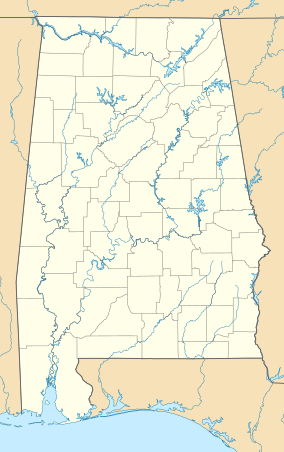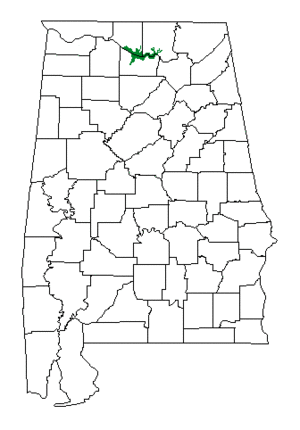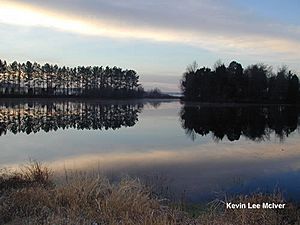Wheeler National Wildlife Refuge facts for kids
Quick facts for kids Wheeler National Wildlife Refuge |
|
|---|---|
|
IUCN Category IV (Habitat/Species Management Area)
|
|
| Location | Morgan, Limestone, and Madison counties, Alabama, United States |
| Nearest city | Decatur, Alabama |
| Area | 34,430.66 acres (139.3359 km2) |
| Established | July 7, 1938 |
| Visitors | 700,000 (in 2003) |
| Governing body | U.S. Fish and Wildlife Service |
| Website | Wheeler NWR |
The Wheeler National Wildlife Refuge is a huge natural area in Alabama. It's about 35,000 acres big, which is like 26,500 football fields! This special place is located along the Tennessee River near Decatur, Alabama. It was created to be a safe home for birds that spend their winters here or are just passing through. The refuge is named after a famous person, Major General Joseph Wheeler.
A part of the refuge, about 4,085 acres, is inside a place called Redstone Arsenal. Some of that land, about 1,500 acres, is managed by NASA's Marshall Space Flight Center. The refuge also helps manage four other National Wildlife Refuges nearby. These include Fern Cave, Key Cave, Sauta Cave, and the Watercress Darter National Wildlife Refuge.
Contents
History of Wheeler Refuge
The story of Wheeler National Wildlife Refuge began in 1934. At that time, the Tennessee Valley Authority (TVA) started buying land. They needed this land for the Wheeler Reservoir and a protective area around it. By 1936, the Tennessee River was blocked by the Wheeler Dam. This dam helped control floods and also made electricity.
In 1938, President Franklin D. Roosevelt officially created the refuge. It was the first National Wildlife Refuge built around a reservoir used for many purposes. The TVA also created special ponds in the reservoir. They would dry these ponds out in spring and summer to stop mosquitoes from breeding.
When these ponds were dry, natural foods for waterfowl grew there. These foods included wild millet and other seed-bearing plants. When the ponds were refilled in winter, birds like ducks and geese came to eat. This is why the refuge is now home to Alabama's largest duck population. It also has the only big group of Canada geese that stay for the winter.
In 1940, the refuge got its current name, Wheeler National Wildlife Refuge. Before that, it was called Wheeler Migratory Waterfowl Refuge.
In 1941, for national safety reasons, some of the refuge land was included inside Redstone Arsenal. Today, NASA's Marshall Space Flight Center manages about 1,500 acres of this land.
What the Land Looks Like
The Wheeler National Wildlife Refuge is located along the Tennessee River. It has many different types of land. You can find wetlands with hardwood trees, and higher areas with mixed hardwood and pine trees. There are also shallow water areas and farm fields.
Out of the refuge's 35,000 acres, about 19,000 acres are land and 16,000 acres are water. Around 10,000 acres are wetlands and forests. Here, you'll see trees like red and white oaks, hickories, and poplars. There are also about 3,000 acres of pine tree farms. Plus, 4,000 to 5,000 acres are used for farming. This mix of habitats makes the refuge a home for many different kinds of wildlife.
Amazing Wildlife and Protected Animals
Wheeler NWR is a very important place for birds. In the past, it hosted up to 60,000 geese and 100,000 ducks! Recently, these numbers have gone down a bit, but it's still a major spot for them. For example, Snow geese are now the most common geese you'll see in winter.
Besides migratory birds, the refuge is home to many other animals. There are 115 types of fish, 74 types of reptiles and amphibians, and 47 types of mammals. You can also find 288 different kinds of songbirds here. Some common animals include squirrels, raccoons, opossums, rabbits, and deer.
About ten endangered species live on the refuge, which means they are very rare and need protection. There's also a small group of American alligators. They were brought back to the area after they had disappeared from northern Alabama a long time ago.
Things to Do at Wheeler Refuge
Wheeler NWR offers many fun activities for visitors. You can explore five hiking trails. These trails range from short walks of about 200 yards to longer hikes of four miles (6 km). They let you see wildlife in different parts of the refuge. There are also six boat launch areas where you can put your boat into the Tennessee River.
Fishing and Hunting Fun
Fishing is very popular at Wheeler NWR. About 200,000 people come to fish here every year! The Tennessee River is a great place to catch fish like bass, sunfish, crappie, and catfish. If you like hunting, about 18,000 acres of the refuge are open for public hunting.
Watching Wildlife
The main visitor center has a special spot to watch waterfowl. It's also a good place to see a red-tailed hawk. There are other viewing stations around the refuge with spotting scopes. You can also visit a wildlife observation tower. It gives you a high-up view of the Beaverdam peninsula. This area is managed especially for Canada geese.
Every winter, thousands of Sandhill Cranes fill the area. The endangered Whooping Crane has also been seen here regularly for the last ten years. Sometimes, more than 10 Whooping Cranes visit! Over 200 types of birds have been identified at the refuge. Wheeler NWR has eight sites on the North Alabama Birding Trail. This is the most sites on the trail within any public land area.
Yearly Events at the Refuge
The Wheeler National Wildlife Refuge hosts several exciting events throughout the year:
- March: Federal Junior Duck Stamp Contest.
- May: Youth Fishing Rodeo, FAWN Festival.
- Summer: Wheeler Day Camps.
- August: United Way's Day of Caring Fishing Rodeo.
- October: Wet and Wild Festival, Southern Wildlife Festival.







